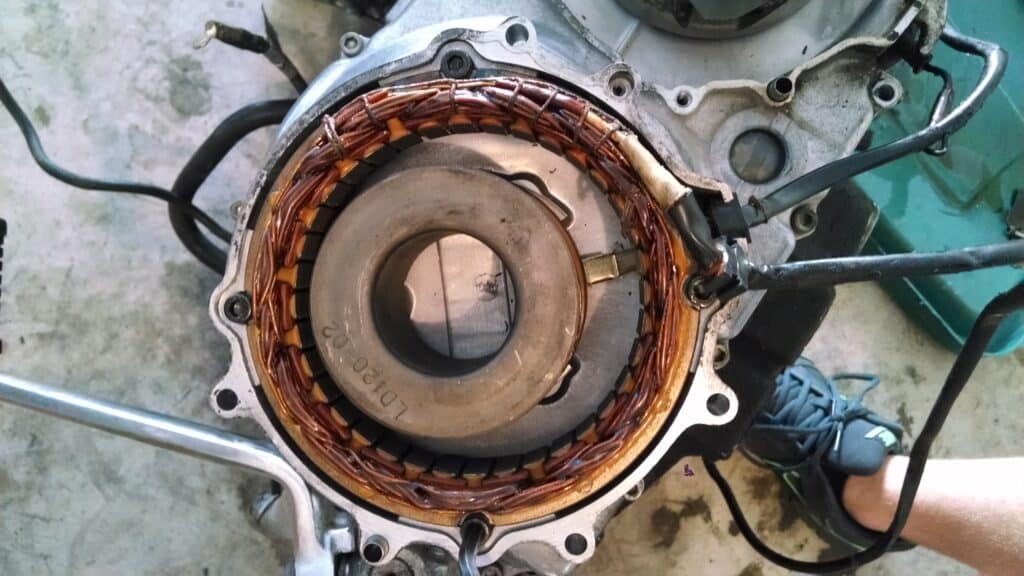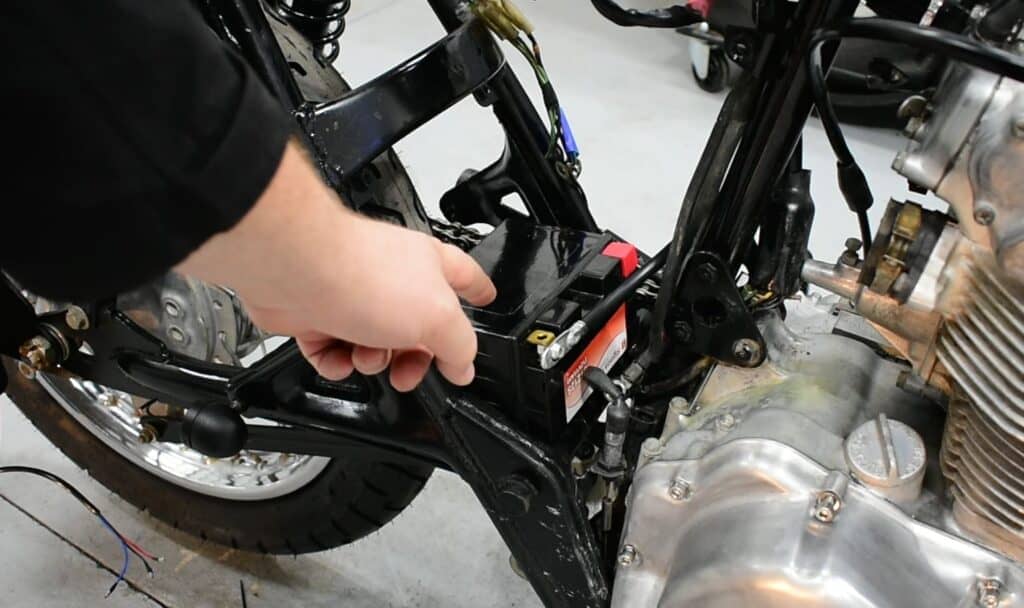
Trying to understand the electrical system on a motorcycle can sometimes be confusing and down right frustrating. Motorcycles have to generate electricity somehow; without it, headlights, blinkers, and even starting it in the first place wouldn’t be possible.
You’ll hear terms such as “alternator,” “stator,” “rectifier,” “magneto,” etc., but what does it all mean and how does it apply to motorcycles? The word “alternator” is probably the most widely known term and many wonder if a motorcycle has one.
So, do motorcycles have alternators? Most motorcycles have a type of alternator that is used to charge/power it’s electrical components while it is running. For a motorcycle, the alternator is more commonly known as a “stator” which is accompanied by a regulator/rectifier. The smaller size of a motorcycle calls for a more simple system compared to regular alternators.
It’s important to know how the charging and electrical systems work on a motorcycle if you are planning on owning one. Through dealing with motorcycle electrical components many times and having owned dozens of bikes myself, I can explain simply what a motorcycle alternator system is and how it works.
How A Motorcycle Alternator Works
The word “alternator” is more of an umbrella term and is used to describe how a vehicle produces power by generating alternating current (or AC).
An alternator is a mechanism that converts mechanical energy into electrical energy. Most vehicles will have some form of an alternator, including motorcycles. The alternator of a motorcycle is more commonly referred to as the “stator.” A stator is considered a less complicated form of an alternator compared to ones found in larger vehicles such as cars. A stator is usually located inside the motorcycle engine and is considered a part of it.
A motorcycle stator comprises of three basic but essential parts: the rotor (also known as the flywheel), stator, and field coil. A stator functions pretty simply. AC (alternating current) is generated as the flywheel rotates around the stator while the motorcycle is on and running. Spokes are organized around the stator with copper coils around each spoke.
The current is created by magnetism. There are two sets of magnets within the system of a stator; one set is stationary on the stator itself and a set is on the flywheel that moves with it around the stator (demonstrated in the video above). When the magnets on the flywheel rotate around the magnets on the stator, it generates that current which is then delivered to the battery to sustain it’s voltage.
Batteries aren’t able to store AC current. So before power is given to the battery, it goes through a regulator/rectifier to convert it into a type of current the battery can store. The rectifier converts the AC to DC (or direct current). In the meantime, the regulator ensures the right amount of voltage is delivered to the battery and doesn’t overbear it.
The regulator/rectifier is part of the alternator system but is usually found in a different spot from the stator on motorcycles. It’s commonly located somewhere in the air stream so it can be naturally cooled while it works it’s magic. The length, winding, and size of the copper wire that is coiled around the spokes all depends on the motorcycle and the amount of power it needs to keep it’s electrical components functioning.
A motorcycle cannot run off a battery alone. If it did, it would drain the battery very quickly and you would be stuck with recharging your battery frequently and would likely be stranded in the middle of nowhere with a dead motorcycle.
The mechanism of the stator is what keeps the battery functioning. Once the motorcycle is turned on and is running, the mechanisms inside the engine that are connected to the flywheel will make it turn.
The kinetic energy (or the power of motion) from the motorcycle engine crankshaft gets the mechanism of the stator to start working, rotating, and generating the current to deliver back to the battery and restore it’s charge. Essentially, the motorcycle is able to recharge itself once it’s on.
Why Motorcycles Have These Types Of Alternators
The alternator system of vehicles is a fairly simple mechanism but plays a vital part in helping the vehicle run. The alternator system in a motorcycle, or the stator, is different from what other vehicles use. Many wonder why it’s different if it’s such a simple process.
If you’ve ever seen an alternator from a car, you’ll see that they’re bulky and take up a bit of room. Motorcycles are less complex than cars and therefore require less complex parts. That’s why a motorcycle uses the system of a stator instead of a whole regular alternator. There simply isn’t the room to fit a large part like that on a motorcycle.
A magneto was more widely used on earlier motorcycles before the implementation of stators. A magneto served the same function as a stator by delivering the necessary power for the spark plugs to work and create the combustion the engine needed, but it was much more basic. As the technology of alternators and stators improved, manufacturers started implementing them in their motorcycles.
Stators since then have been used on most motorcycles and continue to be used today. They’re a perfect middle ground between a basic magneto and the more complicated and bulky alternator found in cars.
Motorcycle Alternators vs. Other Vehicle Alternators
A motorcycle stator and other vehicle alternators, such as an alternator from a car, basically do the same thing. In fact, a car alternator has a stator inside of it which also consists of those copper wires wrapped around spokes.
They both have the magnetized motion where one set is stationary and the other is spun around which generates the power the vehicle needs to function. They both also have a regulator/rectifier to ensure the battery is getting the correct type of voltage as well as the correct amount.
While both a motorcycle stator and a regular alternator pretty much do the same thing, there are some major differences between them. The biggest difference is that alternators found in other vehicles usually has everything put together in one single part whereas a motorcycle stator and it’s accompanying parts are somewhat dispersed throughout the bike.
Another big difference is how the magnets are rotated around each other. In other vehicles, such as a car, an alternator receives it’s rotating mechanism indirectly from the engine. There are usually a series of belts or chains that connect the engine to the alternator. A stator is generated directly from the engine since it’s located inside the engine itself.
The Battery’s Function

A common question I’ll often get when explaining how a stator works on a motorcycle is about the function of the battery. If the stator is generating the current the motorcycle needs to function, then what’s the point of having a battery?
A battery cannot function without a motorcycle stator and a stator cannot function without the motorcycle battery. Though the function of the battery is brief, it’s also very important. The battery is what gets the motorcycle started in the first place.
A stator doesn’t start working and generating power until the motorcycle is actually on. In order to get to that stage, the battery uses it’s current to get the motorcycle started which in turn gets the stator working.
There isn’t much functionality of the battery outside of getting the motorcycle started, but it’s obviously an important part. When a battery starts a motorcycle, it delivers power to the spark plugs to generate a spark that combusts with the air and fuel mixture the carburetor or fuel injector are delivering. Once that combustion starts, the engine begins to function. Once the engine is on, the stator takes over all electrical components.
It takes some power from the battery to get the motorcycle started in the first place so it’s left with a little less power than before the motorcycle started. The stator restores the power the battery had to use to get the bike up and running so the battery will be able to start it again next time.
What Happens When The Alternator/Stator Doesn’t Work
The first and most obvious sign the alternator system on your motorcycle isn’t functioning properly is that your battery doesn’t really seem to be holding a charge. Your motorcycle may act a bit sluggish and the lights may seem to dim more and more over a shorter period of time. You may even come to a point where your motorcycle slowly dies while out for a ride.
This is because all of the power the motorcycle is using is solely coming from the battery alone. A motorcycle cannot function for very long on just battery power since it only has so much current stored.
Your motorcycle will likely struggle getting into or staying in high RPM’s. A revved engine requires more power and if the stator isn’t working, all of that power is coming from the battery which may not have enough current to give at high RPM’s. If you’ve noticed when you try to suddenly accelerate or rev your motorcycle engine and it dies, a bad stator may be the issue.
Along with these two symptoms, you may also notice a “whirring” sound coming from one side of the engine. It will sound similar to manually turning a crank powered flashlight. That means the magnetism in the stator isn’t working. You can learn more about what symptoms to look for if you suspect a faulty stator by reading our article “Symptoms Of A Bad Motorcycle Stator.”
To confirm that a faulty stator is the problem on your motorcycle, you can try manually inspecting it yourself. Check with your owner’s manual to know it’s exact location on your bike. This normally consists of simply taking one of the side covers off of the engine. Notice the condition of the stator. Are there any burn marks, frayed copper wires, or melted components?
As a more simple way to check on the stator, you can also test how much voltage a stator is emitting by using a multimeter; you can do this by locating the stator connector and doing an AC test while the motorcycle is running. The voltage read on each terminal should be similar to each other. If one is reading different from the other, that means you have a faulty stator.
Conclusion
Motorcycles typically rely on a type of alternator, called a stator, to generate electrical power and charge the battery while the engine is running. This has become the standard for most motorcycles because of the efficiency and reliability they have.
If you’d like to learn more about how a motorcycle generates its electrical power, feel free to comment or reach out to me personally, I’d love to nerd out on a topic like this!
